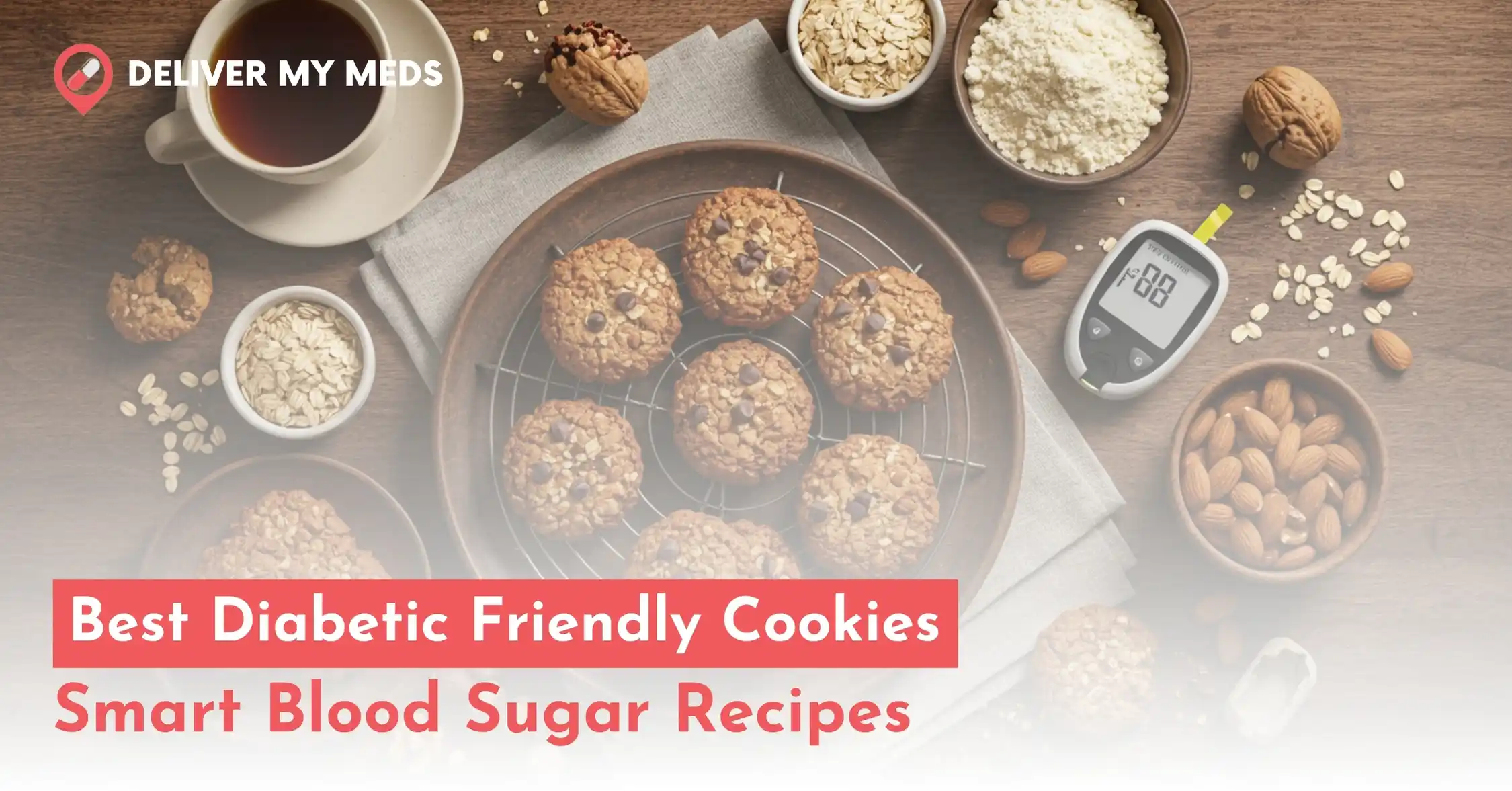
Let’s face it most people love cookies. But if you’re managing blood sugar, the idea of spoiling in something sweet like diabetic desserts or friendly cookies for diabetics might feel unsafe. The good news? With mindful ingredients and portion control, you absolutely can enjoy satisfying treats.
We’re dedicated to helping individuals with diabetes make informed and flavorful choices. This guide offers insights into how different cookies—like double chocolate vs. oatmeal—can fit into a balanced lifestyle, highlights healthy baking options such as low-sugar peanut butter cookies, and provides smart tips and recipes for preparing sugar-free cookies at home. Whether you’re managing your glucose or just looking for better alternatives, this resource is here to support your journey.
Why Conventional Cookies Spike Blood Sugar:
Standard cookies are often loaded with refined white flour and sugar, fast-absorbing carbs that trigger sharp blood sugar and insulin spikes. Frequent sugar surges are linked to long-term complications for diabetics, so ramping down these “empty carbs” is key. According to nutritional science, a typical chocolate chip cookie may contain 10-15 g of sugar, with a glycemic index (GI) that rivals candy. Choosing alternatives like zero-sugar cookies or diabetic oatmeal cookies helps slow down digestion and glucose absorption, creating a safer treat experience. Always check sugar and carb labels.
What Makes Cookies Truly Diabetic Friendly?
A truly diabetic friendly cookie follows three principles:
- Low net carbs are total carbs minus fibre, ideally under 10g per serving.
- Natural, slow-release sweeteners, such as Splenda or stevia, are preferable to refined sugar in recipes like peanut butter cookies.
- Nutrient-rich bases such as oats or almond flour.
This formula turns a treat into a smart snack, delicious yet stable for blood sugar. Low-carb diet cookies, sugar-free peanut butter cookie recipe, and even zero-carb cookies fall into this category when executed thoughtfully by baking experts.
How to Identify Diabetic Cookies on Labels:
Be label-savvy:
- Total carbs: Aim for < 15 g.
- Sugars and added sugars: Look for 0–3 g.
- Sweetener types: prefer erythritol, stevia, or allulose.
- Fiber & protein: Higher is better for slower sugar absorption.
Example: A “sugar-free” cookie with maltodextrin still raises your glucose levels.
Which Sweeteners Are Safest for Diabetics?
Popular low-glycemic sweeteners include:
- Erythritol and allulose: 0 calories & zero insulin response.
- Monk fruit & stevia: Zero-calorie natural sweeteners.
- Splenda (sucralose): Stable under heat, great in Splenda peanut butter cookies.
- Xylitol: Moderate calories; safe for diabetics but toxic to animals.
- Stay Clear of Maltitol: dextrose or agave, they still affect glucose.
(Source: Healthline)
Diabetic Cookies and Portion Control
Even a low-sugar cookie can mess with your blood sugar if you overeat. Here are some expert tips:
- Save a cookie per serving (use plate or portion-sized packaging).
- Pair with protein or healthy fat like peanut butter cookies sugar sugar-free, to slow digestion.
- 2-3 per snack max per serving
Best Store Bought Diabetic Friendly Cookies
Explore these top picks:
Popular Store-Bought Diabetic-Friendly Cookies
| Brand | Each Cookie (g) | Net Carbs (g) | Sweetener |
| Gimmecookies | 20 g | 3 g | Monk fruit, erythritol |
| Zero sugar Oreos | 11 g | 10 g | Maltitol, sucralose |
| Murray sugar free | 14 g | 5 g | Sucralose |
| Voortman sugar-free wafer cookies | 15 g | 4 g | Erythritol, maltitol |
What to Avoid in Packaged “Sugar-Free” Cookies
Not all “sugar-free” labels mean safe for blood sugar. Keep an eye out for these common pitfalls:
-
Sugar alcohols like maltitol: Often used as sweeteners, but they can still raise blood glucose levels when consumed in large amounts.
-
High maltodextrin content: A hidden form of sugar that can cause rapid spikes in blood sugar.
-
Low in fiber or protein: Some products are labelled “sugar-free” but lack nutritional value, making them less satisfying and potentially harmful for glucose control.
-
Buzzwords like “vegan” or “dairy-free”: These don’t necessarily mean low in sugar or diabetic-friendly—always check the ingredients and nutrition label.
Homemade Sugar-Free Cookie Recipes
Looking for tasty treats that won’t spike your blood sugar? Try these easy, sugar-free cookie options:
-
Peanut Butter Cookies – Made with just peanut butter, an egg, and erythritol for a sweet, crumbly bite.
-
Oatmeal Cookies – A fiber-rich snack made with oats, banana, stevia, and raisins.
-
Edible Oatmeal Cookie Dough – Enjoy raw with oats, yogurt, and cinnamon—safe and satisfying.
-
Ginger Snaps – Spiced and cosy cookies made from almond flour, ground ginger, and allulose.
All recipes are low in sugar and can be made in batches—perfect for meal prep or sharing!
Holiday & Seasonal Cookies for Diabetics
Celebrate festive flavours without the blood sugar spikes:
- Sugar-Free Christmas Cookies and Gingerbread Cookies made with almond flour and molasses extract for rich, seasonal taste.
- Low-Sugar Peanut Butter Cookies shaped like snowflakes and topped with a drizzle of sugar-free chocolate.
- Valentine’s Sugar-Free Snickerdoodles offer a deliciously nostalgic treat.
- Easter Oatmeal Cookies crafted for diabetics, featuring wholesome oats and dried berries.
Kid-Friendly Diabetic Cookie Options
The IDF Pocketbook notes that approximately 542,000 children under 15 have Type 1 diabetes worldwide, with 86,000 new cases each year, and the incidence rising by 3–5% annually. Here are some kid-friendly diabetes-friendly snack options that are both tasty and suitable:
- Mini low-sugar peanut butter cookies with mild sweetness and a soft texture, perfect for little teeth.
- Sugar-free cookies made from mashed apples and oats for natural sweetness and fiber.
- No-bake clusters combining oats, seeds, and allulose, are fun to shape and enjoy.
- Baking together offers a great opportunity to teach kids about reading labels and understanding portion sizes.
Popular Variants: Low-Carb Cookie Options
Explore these delicious and diabetes-friendly cookie swaps:
- Double Chocolate Cookies: Made with cocoa powder and sugar-free chocolate chips for rich flavor without the sugar.
- Oatmeal Cookies: Crafted using whole oats and a low-sugar oatmeal cookie recipe for added fiber and a gentle blood sugar impact.
- Low-Sugar Peanut Butter Cookies: Sweetened with erythritol and creamy nut butter instead of traditional sugar.
- Ginger Low-Carb Cookies: Made with almond flour, ground ginger, and allulose for a spicy, low-carb treat.
- Basic Low-Sugar Cookies: Use stevia as a natural sugar substitute to keep sweetness without the glucose spikes
Glycemic Load in Cookies: What It Means for Blood Sugar
| Cookie Type | Net Carbs | Glycemic Index (GI) | Glycemic Load (GL) | What This Means |
| Diabetic Friendly Should have | 3 g | 30 | 0.9 (Very Low) | Safe for blood sugar. Low impact when eaten in moderation. |
| Regular Chocolate Chip Cookie | 10 g | 60 | 6 (High) | Cause a sugar spike. Best to avoid or limit. |
| Low Sugar Cookie with Fiber | 4 g | 35 | 1.4 (Low) | Better choice. Slower effect on blood sugar. |
| High Protein Diabetic Cookie | 5 g | 25 | 1.25 (Low) | Good option. Helps balance carbs with protein. |
(More on GI & GL visit Harvard Medical School)
How Many Cookies Can a Diabetic Eat Per Day?
As a general guideline, aim for 15–30 grams of total carbohydrates per snack. If each diabetic-friendly cookie contains about 5 grams of net carbs, this translates to 3 to 6 cookies per snack. Most people typically enjoy 1 to 2 snacks daily.
To maintain balanced blood sugar levels:
- Avoid stacking multiple carb-heavy desserts on the same day if you include cookies.
- Pair your cookie snack with fiber- or protein-rich foods like nuts or milk to help slow glucose absorption.
- Use carb-tracking tools like FreeStyle Libre 3 or Dexcom G7 to manage your daily carb budget, one snack at a time.
Conclusion: Eat Mindfully, Choose Wisely
Cookies can definitely be part of a healthy diabetic diet when you choose recipes or products with low net carbs, reliable sweeteners, and practice mindful portion control. Whether it’s a trusted brand like Gimmecookies, a wholesome homemade oatmeal cookie, or a festive seasonal treat, the principles of consistency, moderation, and enjoyment remain essential.
Use the glycemic index (GI) and glycemic load (GL) as your guide, aim for about 5 grams of net carbs per cookie, monitor your total carbs per snack, and truly savor the flavors. With the right choices, cookies aren’t off-limits—they’re smarter, better, and more delicious than ever.




